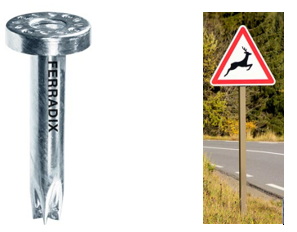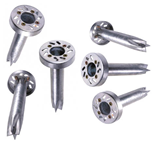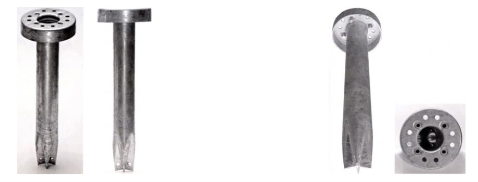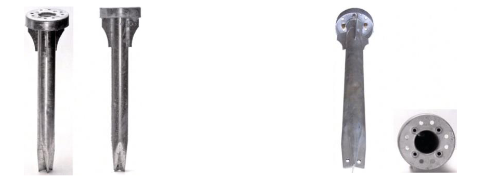Protection against counterfeiting – ground anchors
The patent of your product has expired. And the trade mark that protected its shape has been cancelled. But don’t give up. You may still be able to claim protection against counterfeiting.
The case: The Sträb brothers brought a challenge, with the aim of protecting their well-known ground anchors of metal against counterfeiting. The ground anchors are hammered into the ground to fix traffic signs, light poles or other similar rods in position:

Originally, the ground anchors were protected against counterfeiting under a patent. Upon expiry of the patent protection, Sträb tried to obtain protection against counterfeiting by registering a three-dimensional trade mark, which had the following content:

Problems arose when a competitor, the Slovenian company Andotehna d.o.o., produced the following ground anchors for paved surfaces and soft soils, and distributed them in Germany:


Sträb claimed protection from its trade mark against this imitation. However, Andotehna filed a cancellation request, following which the EUIPO did indeed cancel the Sträb mark, on the basis that three-dimensional marks cannot be protected if all the essential design features of the shape of the goods perform a technical function. That was obviously the case here.
Any protection against imitation, whether provided by patent or trade mark, had now gone. But had Sträb entirely lost its ability to protect its product against imitation?
No, according to the Federal Court of Justice. Even for products that are not (any longer) protected by patent or trade mark, protection against counterfeiting can still be achieved if the imitation is classed as unfair. In the case of technical features that – as in this case – are freely interchangeable, the public may attach importance to the product having originated from a particular company or they might associate certain expectations with the product in terms of quality. Anyone who takes advantage of this will be acting unfairly.
The original product and that of the competitor were almost identical. The cylindrical shaft, the round-bottomed pot, the straight-edged rim and the special tip, the dimensions and the openings in the rim of the plate were all essentially the same. Moreover, the features of the Sträb ground anchors were not essential in terms of performing a technical function. Not only was the near-identical imitation was liable to deceive the public as to the commercial origin of the competing stakes, but the reputation of the original product was also being exploited. A strict standard applies in the case of (almost) identical imitation, meaning that the imitator cannot in principle plead that they have merely adopted an appropriate technical solution that is not protected by special rights.
The free of movement of goods within the European Union does not preclude a ban in Germany. European law does not protect unfair conduct. In addition, Andotehna was unable to prove that it had offered the ground stakes as solely its own product, while the stakes also lacked a manufacturer’s mark. Furthermore, the stakes were not exclusively available only through Andotehna’s own catalogues. Nor was it open to Andotehna to invoke the prior art argument, which is in principle available to all after the expiry of a patent. According to this prior art rule, it would only have been possible for Andotehna to adopt the design features that were both technically necessary and not (or no longer) under special legal protection. However, the shape of the Sträb stake was not absolutely necessary in order to fulfil the technical purpose; there were other ground anchors with other shapes that fulfilled the same technical purpose. To avoid unfairness, it was reasonable to expect Andotehna to switch to another appropriate technical solution, BGH, 15 December 2016 – I ZR 197/15.
Learnings. Even if you can no longer rely on a patent or trade mark for protection against imitations, your product may still be protected. However, the counterfeit features must not be essential to the performance of a technical function. A competitor who enters the market after the expiry of the original manufacturer’s patent protection could, however, still avoid the risk of a challenge based on the product being deceptive in terms of origin and/or amounting to an exploitation of reputation, by clearly informing the target public via its own labelling that the product is different from the original product. Each individual case must be carefully analysed according to this aspect.
On the inability to protect technical products using three-dimensional trade marks, see also:
Trade mark for patented product – Global Yoshikin
Trade mark protection for creative product – Rubik’s cube
Trademark protection for design product – Gömböc